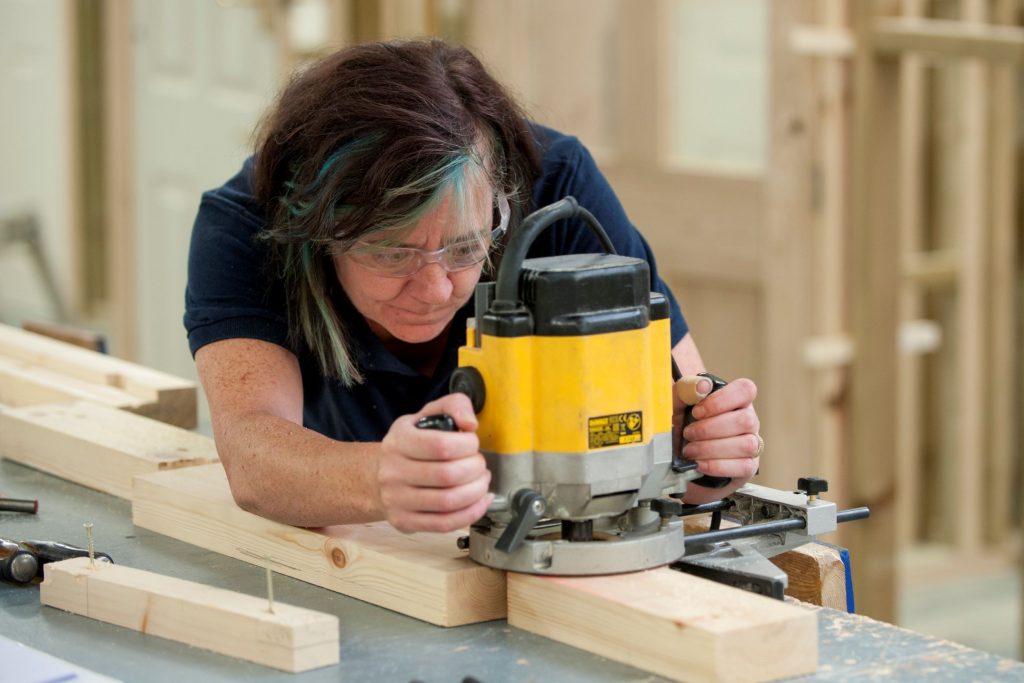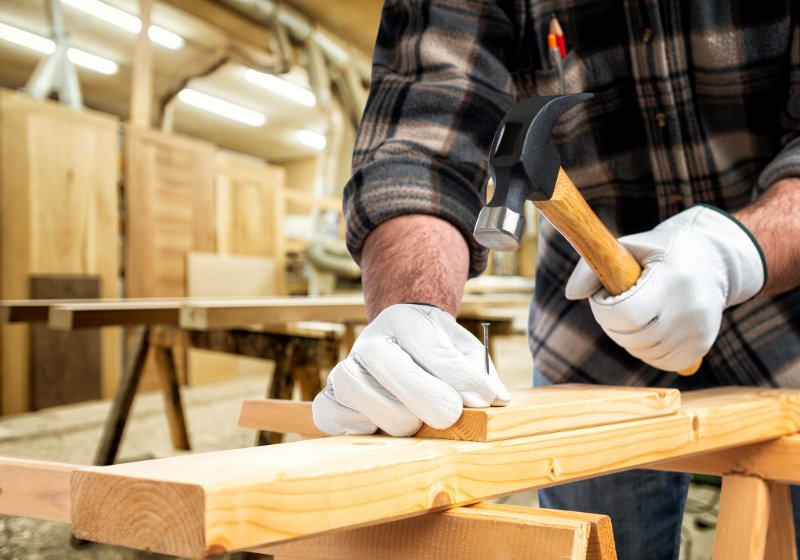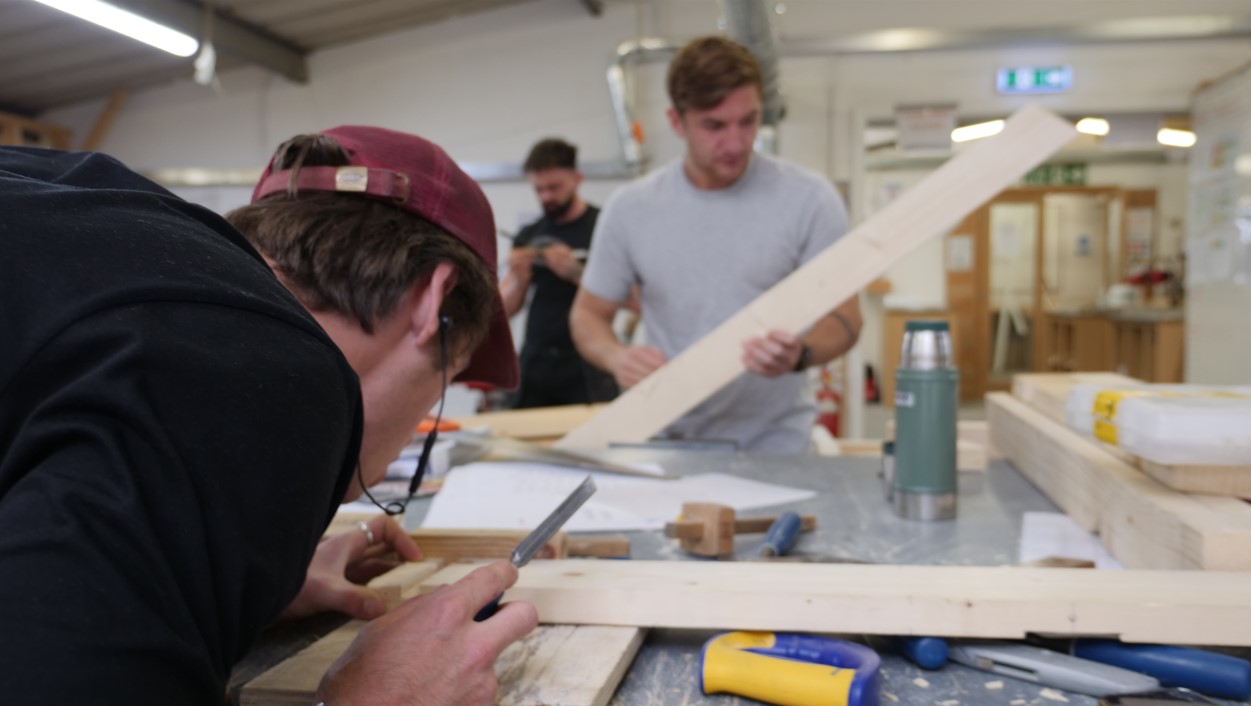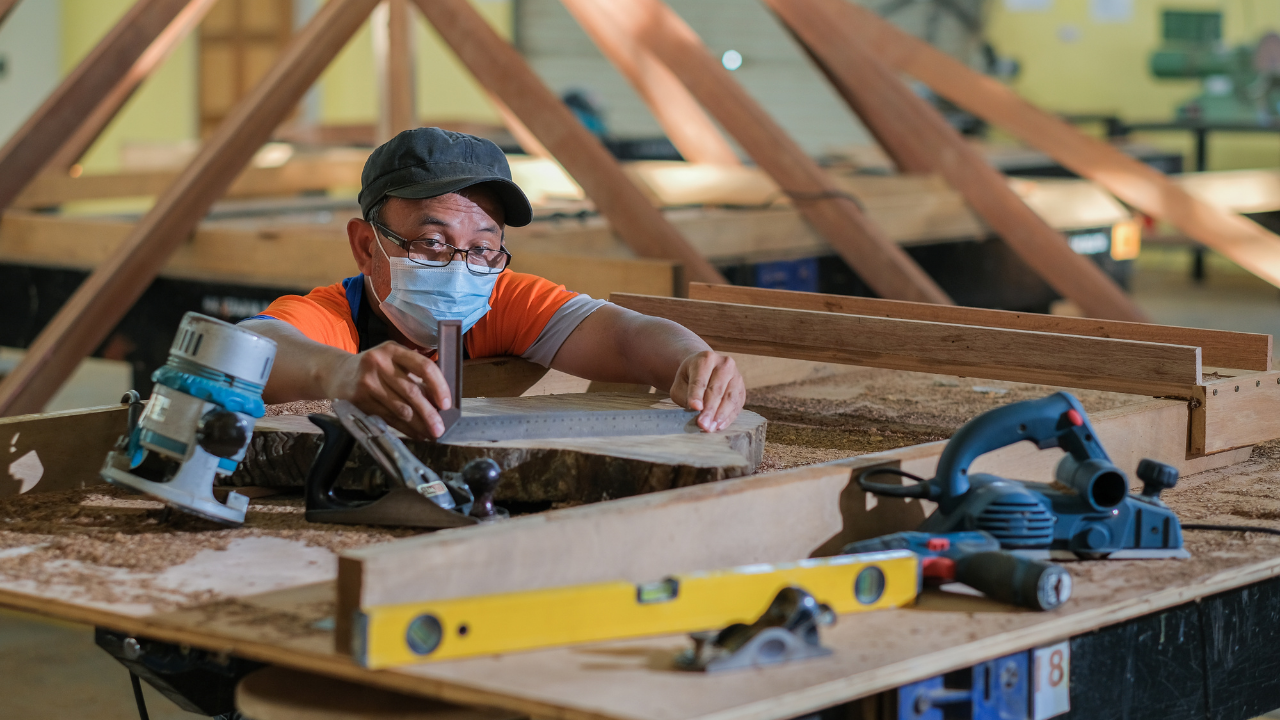Carpentry is a trade that has been integral to construction and home improvement for centuries. Whether you’re building a new home, remodeling a kitchen, or crafting custom furniture, the skills required for carpentry are essential. But what exactly are the skills you need to succeed in this profession?
Carpentry is the craft of working with wood to build, repair, and install various structures, furniture, and fixtures. The scope of carpentry spans many different areas and can be divided into several types of specialties, including:
- Framing Carpentry: Involves building the structural framework for houses, commercial buildings, and other large projects.
- Finish Carpentry: Focuses on the finer details, such as installing doors, windows, trim, and molding.
- Cabinetmaking: Specializes in crafting custom cabinetry and furniture.
- Timber Framing: The traditional method of constructing large wooden frames, often seen in barns and historical buildings.
Why Are Carpentry Skills Important?
To be a successful carpenter, you need a combination of technical abilities and soft skills. Carpentry skills are not only about how to use tools but also about understanding the materials you’re working with, interpreting blueprints, and ensuring the safety and quality of your work.
Whether you are building the frame of a house or installing custom cabinets, your skills directly impact the outcome of the project. Quality craftsmanship is valued in carpentry, and gaining a thorough understanding of the trade will help you achieve professional success.
Essential Technical Skills Every Carpenter Should Have
When it comes to carpentry, the technical skills are fundamental. Whether you’re working with wood, metal, or other materials, these skills are crucial to delivering a professional result. Here’s a breakdown of the most essential technical carpentry skills:
Measurement and Precision
Accurate measurements are the backbone of any carpentry project. Whether you are building a bookshelf, framing a house, or cutting a piece of trim, precise measurements are crucial to ensuring that everything fits together properly.
Why is measurement important?
- Correctness: A small error in measurement can lead to materials that don’t fit or structural issues.
- Material Efficiency: By measuring accurately, you can avoid wasting materials and reduce costs.
Common Tools for Measuring in Carpentry:
- Tape Measure: A flexible, retractable tape used for general measurements.
- Calipers: A tool used for measuring the thickness and depth of materials.
- Carpenter’s Square (Speed Square): Used for marking straight lines, right angles, and measuring lengths.
- Ruler or Yardstick: For more precise, short measurements.
Pro Tip: Always double-check your measurements before cutting. It’s easy to make a mistake, and in carpentry, it’s better to be cautious than waste materials.
Knowledge of Wood Types and Materials
A key skill for carpenters is understanding the various types of wood and materials used in their work. Different woods have different properties, such as strength, texture, and workability. Selecting the right material for the job is essential for both the structural integrity and aesthetic quality of the project.
Types of Wood Used in Carpentry:
- Softwoods: These woods come from conifer trees (e.g., pine, fir, cedar) and are typically used for framing and outdoor projects.
- Hardwoods: Hardwood comes from deciduous trees (e.g., oak, maple, cherry). It’s ideal for fine furniture, flooring, and cabinetry due to its durability and attractive appearance.
- Plywood and MDF: Engineered wood products like plywood, medium-density fiberboard (MDF), and oriented strand board (OSB) are commonly used for cabinetry, paneling, and furniture.
Key Considerations When Working with Wood:
- Moisture Content: Wood expands and contracts depending on humidity, so understanding moisture levels is essential to prevent warping.
- Grain Direction: The direction of the wood’s grain can affect its strength and aesthetic appeal.
- Workability: Some woods, like pine, are easier to work with than others, such as hardwoods like walnut or cherry.
By knowing which wood to choose and how it reacts to different conditions, you’ll be able to select the best materials for your carpentry projects.
Tool Mastery
One of the defining skills you need for carpentry is the ability to use a variety of tools. Tools are your primary method of working with wood and other materials, and mastering them is essential for any carpenter. From basic hand tools to specialized power tools, knowing when and how to use them will make your work faster, safer, and more efficient.
Basic Hand Tools Every Carpenter Needs:
- Hammer: Used for driving nails and other fasteners.
- Saws: Including hand saws, coping saws, and hack saws for cutting wood to size.
- Screwdrivers: Essential for driving screws and assembling projects.
- Utility Knife: Great for precise cuts, scoring materials, and opening packaging.
Power Tools to Master:
- Circular Saw: Used for cutting through wood quickly and accurately.
- Miter Saw: Ideal for making precise crosscuts and angled cuts in wood.
- Drill: A must-have for making holes and driving screws.
- Jigsaw: Used for cutting curves and intricate shapes in wood.
Safety First! Mastering tools is not just about knowing how to use them but also knowing how to use them safely. Always wear safety gear (gloves, goggles, etc.) and read user manuals before using new tools.
Joinery Techniques
Joinery refers to the techniques used to join pieces of wood together. Understanding different types of joints and when to use them is a crucial skill for any carpenter. Good joinery ensures that your projects are both durable and aesthetically pleasing.
Common Types of Wood Joints:
- Butt Joint: Two pieces of wood are joined end to end, the simplest and most basic joint.
- Dovetail Joint: A highly durable joint used primarily in fine furniture and cabinetry. It’s known for its strong, interlocking shape.
- Mortise and Tenon Joint: One of the oldest and strongest joints, often used in framing and large-scale woodworking projects.
- Lap Joint: Two pieces of wood overlap to join together, often used for frames and shelves.
Pro Tip: Choose joints based on the strength needed for the project. For example, a dovetail joint is ideal for drawers and fine cabinetry, while a butt joint may be sufficient for rough framing work.
Reading and Interpreting Blueprints and Plans
Being able to read blueprints and construction plans is an essential skill for carpenters working on complex projects. Blueprints give you a detailed guide on measurements, materials, and assembly, and understanding them ensures that the final product matches the design.
What to Look for on Blueprints:
- Dimensions and Measurements: Exact measurements to ensure everything fits together.
- Material Specifications: Information on the type and quantity of materials needed.
- Construction Details: Specifics on joints, finishes, and other carpentry details.
Pro Tip: If you’re ever uncertain about a blueprint or plan, don’t hesitate to ask for clarification before you start cutting or assembling.

Soft Skills for Success in Carpentry
While technical skills like measuring, cutting, and tool usage are the foundation of carpentry, soft skills play a significant role in determining your success. These personal qualities can elevate your craftsmanship, improve your ability to work with clients and coworkers, and even affect the efficiency of your worksite.
Problem Solving and Creativity
Carpentry is not just about following instructions; it often requires creative problem-solving. On a job site, you might encounter unexpected challenges such as irregular wall shapes, non-standard materials, or design alterations that weren’t anticipated in the blueprints. Being able to think on your feet and come up with practical solutions is a key skill for any carpenter.
How Problem-Solving Skills Help Carpenters:
- Adapting to Unforeseen Changes: If a wall is out of square or materials arrive damaged, you need to find ways to work around the problem.
- Customization and Design Solutions: Many carpenters, especially those in finish carpentry or cabinetmaking, work with clients to customize furniture or structures. Creativity is crucial when crafting pieces that meet both functional and aesthetic needs.
For example, a custom bookshelf design might need adjustments to fit into a non-standard space, requiring you to come up with solutions that preserve the overall design and functionality.
Communication and Collaboration
Communication is a cornerstone of effective carpentry. Whether you’re working on a team of carpenters or collaborating with electricians, plumbers, or other contractors, clear and concise communication ensures that everyone is on the same page.
Key Aspects of Communication in Carpentry:
- Client Interaction: Explaining the carpentry process and offering expert advice to clients helps build trust and ensures that the work aligns with their expectations.
- Team Collaboration: In large-scale construction projects, carpenters often work alongside other trades. Good communication ensures that tasks are coordinated and timelines are adhered to.
- Providing Feedback: Whether you’re working with a novice or an experienced crew, offering and receiving constructive feedback can enhance teamwork and improve the final product.
Pro Tip: Developing good listening skills is just as important as speaking clearly. Pay close attention to project specifications, client feedback, and team instructions.
Attention to Detail
Carpentry is a profession where attention to detail can make all the difference between a successful project and a flawed one. Small errors in measurement, tool usage, or assembly can have a ripple effect on the entire project.
How Attention to Detail Benefits Carpenters:
- Improves Quality: A well-crafted piece of furniture or a structurally sound frame requires careful attention to the finest details.
- Ensures Accuracy: Even a slight miscalculation can throw off dimensions or the fit of materials, which is why checking work multiple times is important.
- Professional Reputation: A carpenter who consistently produces flawless work is more likely to gain repeat business and referrals.
A good example is finish carpentry where intricate moldings, crown work, or custom cabinets demand precision. Any inconsistency in alignment or measurement can detract from the overall aesthetic appeal.
Pro Tip: Always step back and visually inspect your work from different angles to ensure everything lines up correctly.
Time Management
In carpentry, managing your time effectively is a key skill. Whether you’re working on a construction site or crafting a custom piece of furniture, being able to balance speed with quality is crucial to delivering the best results without compromising safety or craftsmanship.
Why Time Management is Important for Carpenters:
- Meeting Deadlines: Many carpentry projects, especially in construction, are tied to strict timelines. If a project takes longer than expected, it can affect other trades and lead to delayed payments.
- Balancing Multiple Tasks: On a typical carpentry job, you may be juggling multiple tasks such as measuring, cutting, assembling, and finishing. Prioritizing tasks helps keep everything on track.
- Efficiency Without Cutting Corners: Time management allows you to work faster without sacrificing quality or safety.
For instance, if you’re working on a residential project, time management ensures that framing work is completed before electrical work begins, maintaining a smooth workflow on the job site.
Pro Tip: Use tools like task lists, project management apps, and time tracking methods to stay organized and improve productivity on the job site.
Safety Skills Every Carpenter Needs
Carpentry involves working with powerful tools and materials that can be dangerous if not handled properly. Safety skills are among the most important carpentry skills you need to learn and practice regularly. A safe work environment reduces the risk of accidents, ensures that you’re working legally, and promotes a productive and efficient work environment.
Workplace Safety Practices
Safety in carpentry isn’t just about wearing personal protective equipment (PPE); it’s about understanding potential hazards and following best practices to avoid accidents.
Key Safety Practices for Carpenters:
- Wearing Personal Protective Equipment (PPE): Always wear safety goggles, ear protection, gloves, and steel-toed boots when working with tools.
- Tool Safety: Understand how to operate each tool properly and follow the manufacturer’s instructions to prevent accidents.
- Lifting and Carrying Materials: Avoid back strain by using proper lifting techniques when handling heavy or awkward materials.
- Maintaining a Clean Work Area: Keeping your work area free of clutter can prevent tripping hazards and help you focus on the task at hand.
Understanding OSHA Guidelines for Carpenters
OSHA (Occupational Safety and Health Administration) sets guidelines to ensure the safety of workers in all industries, including carpentry. These guidelines help create a safer work environment by identifying hazards and recommending control measures.
Important OSHA Guidelines for Carpenters:
- Fall Protection: Use safety harnesses and guardrails when working at heights.
- Power Tool Safety: Ensure that tools have proper safeguards and are well-maintained.
- Personal Protective Equipment: OSHA mandates the use of PPE in certain work environments to prevent injuries.
Pro Tip: Familiarize yourself with OSHA standards for carpentry and make sure your worksite follows these guidelines. Regularly participate in safety training programs and refresher courses.
First Aid and Emergency Procedures
Even with the best safety practices in place, accidents can happen. Having basic first aid knowledge and an understanding of emergency procedures can help you respond effectively if an injury occurs on the job site.
Basic First Aid Knowledge for Carpenters:
- Cuts and Abrasions: Know how to clean and dress minor cuts and scrapes, which are common in carpentry.
- Sprains and Strains: Familiarize yourself with how to treat sprains or strains from lifting heavy objects.
- Handling Serious Injuries: Understand how to recognize and treat more severe injuries (e.g., broken bones, electrical burns, eye injuries).
Additionally, ensure that your worksite has a fully stocked first aid kit and that you and your team know where it’s located. Emergency response protocols should be clearly established, and workers should know how to report accidents quickly.

How to Build and Improve Your Carpentry Skills
Carpentry, like any craft, is not a one-and-done skill set. It’s something you continually develop over time, whether you’re just starting out or looking to refine your expertise.
Formal Education vs. Apprenticeship
When it comes to learning carpentry skills, there are two primary routes: formal education and hands-on apprenticeship. Both methods offer valuable experience, but they come with distinct advantages and challenges.
Formal Education: Trade Schools and Community Colleges
Many aspiring carpenters attend trade schools or community colleges to gain a solid foundation in carpentry. These programs typically offer structured curriculums that teach both the technical and theoretical aspects of the trade.
Advantages of Formal Education:
- Structured Learning: Programs are organized, offering a step-by-step approach to learning carpentry, from basic skills to advanced techniques.
- Certifications: Many programs offer certifications that can help you stand out in the job market.
- Classroom and Hands-On Training: These programs often provide a balance of theoretical knowledge and practical experience, giving you a well-rounded education.
Challenges of Formal Education:
- Cost: Trade schools can be expensive, though financial aid or apprenticeships might help offset costs.
- Time Commitment: These programs often last one to two years, which can be a long time for someone eager to start working.
Apprenticeship: Hands-On Learning with a Master
An apprenticeship is a traditional method of learning carpentry that involves working under an experienced carpenter while gaining practical, on-the-job training. Many carpenters start their careers this way, working for contractors, construction companies, or established carpenters.
Advantages of Apprenticeship:
- Real-World Experience: Working directly on projects allows you to apply skills immediately and learn through trial and error.
- Mentorship: Learning from an experienced professional can offer personalized guidance and valuable insights that you can’t always get in a classroom.
- Earn While You Learn: Unlike formal education, apprenticeships often allow you to earn a wage while learning the trade.
Challenges of Apprenticeship:
- Longer Time to Master: Becoming proficient through an apprenticeship can take several years, but the skills you develop will be well-tested in real-world conditions.
- Finding the Right Mentor: Not all apprenticeships offer the same level of training or mentorship, so finding a skilled carpenter to work with is essential.
Which Path Is Right for You?
Both education and apprenticeship are excellent paths to becoming a skilled carpenter. If you prefer structured learning with a defined curriculum, a trade school might be the best option. However, if you learn best by doing and want to get paid while gaining experience, an apprenticeship could be the way to go.
Hands-On Practice and Personal Projects
While formal education and apprenticeships are valuable, there’s no substitute for hands-on practice. Building your own projects allows you to experiment with new techniques, refine your skills, and discover your strengths and weaknesses. Even if you don’t have access to professional carpentry jobs right away, working on personal projects can help you hone your craft.
Why Personal Projects Are Important:
- Confidence Building: Successfully completing a project boosts your confidence and reinforces what you’ve learned.
- Skill Refinement: Personal projects allow you to try new tools, techniques, and materials without the pressure of a paying client or deadline.
- Creative Freedom: You have the flexibility to design your projects, which will help you develop your creative and design skills.
Project Ideas for Beginners:
- Simple Shelving Units: A great way to practice measuring, cutting, and assembling.
- Wooden Planter Boxes: A small, easy project that allows you to work with joints and finishing techniques.
- Birdhouses or Small Furniture: Perfect for practicing finer details like sanding, finishing, and precise cutting.
For example, crafting your own bookshelf or coffee table will help you build experience in both woodworking and finishing. These projects don’t have to be large or complex but should include a range of carpentry skills that will help you grow as a craftsman.
Seeking Out Mentorship and Networking
In addition to formal education and hands-on practice, mentorship is one of the best ways to accelerate your learning. Experienced carpenters can provide guidance, share tips and tricks, and offer insights into how to handle common challenges in the trade.
Benefits of Mentorship:
- Knowledge Sharing: A mentor can teach you the nuances of carpentry that can’t always be learned from books or classes.
- Professional Growth: Mentors often help you understand the business side of carpentry, such as managing clients, setting prices, and working with other trades.
- Networking Opportunities: A mentor can introduce you to valuable contacts in the industry, helping you find job opportunities or work on larger projects.
How to Find a Mentor:
- Join Carpentry Associations: Many national and regional carpentry associations offer resources, training, and networking opportunities.
- Volunteer or Work for Experienced Carpenters: Offering to help a skilled carpenter on their projects can provide informal mentorship.
- Online Forums and Communities: There are many online forums (e.g., Reddit, carpentry-specific communities) where carpenters share advice and experiences.
Continuing Education and Certifications
Carpentry is a constantly evolving field, with new tools, materials, and techniques emerging all the time. To stay competitive, it’s important to continue your education throughout your career. Whether it’s through formal certifications, advanced courses, or specialized training, ongoing learning can help you advance in the field.
Types of Continuing Education:
- Advanced Carpentry Courses: These can focus on areas like green building, eco-friendly carpentry, or historical restoration.
- Online Learning: Platforms like Udemy, LinkedIn Learning, and YouTube offer a wide range of online tutorials and courses that cover specific carpentry skills or techniques.
- Certifications: Many carpenters pursue certifications to show their expertise. Examples include National Carpentry Certification or specialized certifications in areas like finish carpentry or green building techniques.
Pro Tip: Investing in advanced certifications or specialized training can help you increase your earning potential and open up opportunities in niche areas of carpentry, such as custom cabinetry or timber framing.

Carpentry Skills for Different Carpentry Specializations
Carpentry encompasses a wide range of specialties, each requiring specific skill sets tailored to different types of projects. Whether you’re interested in building the structural framework of a house or crafting detailed furniture, understanding the unique demands of each specialization will help you decide where to focus your efforts.
Framing Carpentry
Framing carpentry is the backbone of construction. Framing carpenters are responsible for creating the skeletal structure of buildings, including walls, floors, roofs, and ceilings. These carpenters work primarily with wood and engineered materials like plywood and OSB.
Key Skills for Framing Carpenters:
- Structural Knowledge: Understanding load-bearing walls, joists, beams, and trusses is critical.
- Blueprint Interpretation: Reading and following construction plans accurately.
- Speed and Precision: Efficiency is essential when assembling large structures on tight deadlines.
Tools Commonly Used in Framing Carpentry:
- Power saws, nail guns, hammers, and measuring tools.
- Laser levels for ensuring precise alignment.
Interesting Fact: Framing carpenters often work at great heights, requiring excellent balance and a focus on safety.
Finish Carpentry
Finish carpentry involves the finer details that make a project complete. These carpenters focus on tasks like installing trim, molding, doors, and cabinetry, where precision and an eye for aesthetics are paramount.
Key Skills for Finish Carpenters:
- Attention to Detail: Even minor mistakes in measurements or cuts can affect the look of the finished product.
- Advanced Tool Skills: Proficiency with tools like miter saws, routers, and planers.
- Understanding of Design: Being able to align your work with a client’s vision or architectural style.
Common Materials in Finish Carpentry:
- Hardwood, softwood, MDF, and veneer.
- High-quality paints, stains, and finishes.
Pro Tip: Many finish carpenters develop their own methods for creating smooth, flawless joints, such as using caulk or wood filler for perfect transitions.
Cabinetmaking and Furniture Carpentry
This specialization focuses on crafting custom cabinetry, furniture, and woodwork. Cabinetmakers and furniture carpenters often work in workshops rather than construction sites, allowing for controlled environments to achieve precision and artistry.
Key Skills for Cabinetmakers:
- Joinery Expertise: Dovetail joints, mortise and tenon, and other precise joinery techniques are critical.
- Design and Creativity: Many projects involve creating unique or bespoke designs tailored to client needs.
- Finishing Techniques: Skills in staining, painting, and applying protective coatings are essential.
Tools and Equipment Used in Cabinetmaking:
- Specialized tools like table saws, band saws, and edge banders.
- Sanding and polishing machines for professional finishes.
Case Study: A skilled cabinetmaker was tasked with creating a custom set of kitchen cabinets for a historic home. By carefully selecting matching woods and using traditional joinery methods, they ensured the cabinets complemented the home’s vintage charm while providing modern functionality.
Timber Framing
Timber framing is a traditional form of carpentry that uses large wooden beams and intricate joinery to create structures. It’s commonly used for barns, historical restorations, and eco-friendly building designs.
Key Skills for Timber Framers:
- Specialized Joinery: Techniques such as pegged mortise and tenon joints, which require no nails or screws.
- Structural Knowledge: Understanding the loads and forces acting on large timbers.
- Precision Cutting: Ensuring each timber fits perfectly into the structure.
Tools Unique to Timber Framing:
- Large chisels, mallets, and saws designed for cutting and shaping massive timbers.
- Modern timber framers may also use CNC machines for precision cutting.
Interesting Fact: Timber framing is experiencing a resurgence in sustainable construction because it uses fewer industrial materials and provides excellent insulation properties.
Why Specialization Matters
Choosing a specialization in carpentry allows you to focus on the skills and techniques that interest you the most. It also helps you stand out in the industry, whether as a highly sought-after finish carpenter, a meticulous cabinetmaker, or a builder of awe-inspiring timber-framed structures.